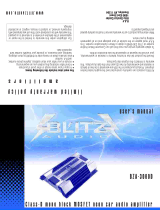
Installation & Precautions
Installation
Precautions
6
1. Find a suitable location in the vehicle to mount the amplifier.
2. Make sure there is sufficient air flow around the intended mounting
location.
3. Bolt the amplifier to the mounting surface.
4. Connect the power ground terminal to the nearest point on the chassis
of the car. Keep this ground wire less than one meter (39") in length.
Use 8 gauge wire.
5. Connect the remote terminal to the remote output of the head unit using
14 gauge wire.
6. Connect an empty fuse holder within 300 mm (12") of the battery and run
8 gauge or larger high quality cable from this fuse to the amplifier location.
7. Make sure there is no fuse in this fuse holder. Then make the connection
to the "BATT"connection on the amplifier.
8. If multiple amplifiers are being used, use cables (each with it's own fuse
at the battery) or a # O or #2 cable from the fuse holder at the battery to
a distribution block at or near the amplifier's location.
9. Connect all line inputs and outputs using high-quality RCA-RCA cables.
10. Insert fuse(s) at the battery fuse holder(s).
11. Recheck all connections before powering up.
12. Set all level controls to their least sensitive positions and set all
crossover controls, switches, etc. To the desired frequency or position.
13. Once the system is powered up, set the volume control on the head unit
to about the 2 O'clock position, and then set all the amplifiers' level
controls for maximum output level.
14. Further fine tuning of the various controls may be m\necessary to
obtain the desired results.
1. Before you drill or cut any holes, investigate your car's layout very carefully.
Take care when you work near the gas tank, fuel lines, hydraulic lines and
electrical wiring..
2. Do not operate the amplifier when it is unmounted. Attach all audio system
components securely within the automobile to prevent damage, especially in
an accident
3. Do not mount this amplifier so that the wire connections are unprotected or
in a pinched condition, or likely to be damaged by nearby objects. Be sure to
select a location inside your vehicle which has adequate ventilation..
4. Before making or breaking power connections in your system, disconnect the
vehicle battery. Confirm that your head unit or other equipment is turned off
while connecting the input jacks and speaker terminals.
5. If you need to replace the power fuse, only replace it with a fuse identical to
that supplied with the system. Using a fuse fo a different type or rating may
result in damage to your system which isn't covered by the manufacturer's
warranty.


















